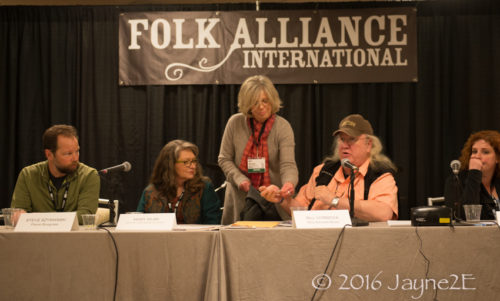
On Feb 18, I was privileged to host a discussion of music archiving at the Folk Alliance conference in Kansas City. My very able and well-organized panelists were Steve Szymanski of Planet Bluegrass who discussed audio/video production and archives, and photography and book publishing; Mary Muse of Kerrville Folk Festivals who discussed the broad range of materials that constitute a festival’s history and what to do with them when the barn is full; Bil VornDick, veteran record producer/engineer who advised project studio operators and self-releasing musicians on what session material to save in what formats and how to label it; and Kate Blalack of the Woody Guthrie Center, who set us all straight on proper storage of archives and maintaining context to retain their cultural value.
UPDATE 3-21 -16: Of course, we archived the audio from this panel presentation at Folk Alliance! You’ll find it at Airshow’s Soundcloud page. (Don’t miss Bil’s priceless tip on how to get a balky hard drive to spin, @ 7:22 into his talk.) Kate Blalack brought a terrific PowerPoint to accompany her talk, and we’ve included it as a PDF here. You can follow along with her portion of the presentation. Sorry, the Q’s were off-mic, but you can hear the A’s.
As the panel moderator, I knew I’d never have time to throw in my two cents, so I jump-started the panel’s printed resource handout with some of my own favorites. These live links should make it easier for you to access the valuable information.
Tips, tricks and resources from me:
If you want to keep the stuff:
1. The ARSC Guide to Audio Preservation (2015) For download or purchase
The Association of Recorded Sound Collections’ bible of digital audio preservation, with notes on all vintage audio media.
2. BWF MetaEdit
Free open-source software from AVPreserve for data entry into the metadata chunk of a Broadcast Wave Format (BWF) file, a preferred audio preservation format.
3. MediaScore and MediaRivers
Two tools developed with Indiana University to prioritize preservation among various audio and video media ( SCORE=Media Selection: Condition, Obsolescence, and Risk Evaluation)
If you want to figure out how to get rid of it:
4. “The Life-Changing Magic of Tidying Up”, by Marie Kondo, Ten Speed Press.
When you read “t-shirt” or “socks,” just substitute “album” or “poster.”
5. Find a dealer or appraiser for audio collections on the ARSC membership list
Who needs an institutional sponsor? You can create your own online museum:
6. Pop-Up Archive
An affordable online platform for automated transcription of spoken word audio. Originally designed to help podcasters with SEO, it’s become more robust with editing and tagging tools, to enable you to post transcripts and audio/video. Pricing plans range from individual to enterprise-level.
7. Archive-It!
A service of the Internet Archive whereby you can develop and host a collection of (live and archived) websites to document an aspect of music (or any cultural phenomenon). See Ann’s blog post on the topic, describing a cool NYU School of Music project.
8. Omeka
A free, flexible web publishing platform for your online museum. It powers the Caffe Lena History project website.
If you want to compete nationally for funding:
NEH, planning and preservation grants–Josh Sternfeld, jsternfeld@neh.gov
GRAMMY Foundation, planning and preservation grants–Kate Allen, kate.allen@grammy.com
Council on Library and Information Resources (CLIR), Preservation and access grants–Nicole Ferraiolo, NFerraiolo@CLIR.ORG
More from Bil VornDick on digital media deliverables, labeling and how to keep your personal creative archive in order:
One-sheets and manuals on labeling, deliverables, metadata and more for artists and producers
1. From NARAS/AES, Delivery Recommendations for Master Recordings
2.From NARAS/AES, Session Documentation forms for tracking, mixing
3. From NARAS/AES, Media ID Label for tracking, mixing sessions, and Instructions
4. From AES, Technical 5.1 Channel Music Production Guidelines
5. From NARAS/AES, DAW Guidelines and One-Sheets
From Kate Blalack, Woody Guthrie Center, these are some resources real archivists rely on:
1. Northeast Document Conservation Center Leaflets
Easy to understand FREE guides and resources on preservation and other information related to archiving and document and artifact care. NDCC also offers additional free resources and online webinars. Includes a section devoted to audio preservation.
2. Image Permanence Institute
IPI® is a nonprofit, university-based laboratory devoted to preservation research. It is the world’s largest independent laboratory with this specific scope. IPI’s areas of research and expertise:
• The nature of photographic images and other forms of print media
• Information and technical support for the archival and photographic conservation profession
• Sustainable practices in environmental management and preservation
• The stability of imaging and information media and digital print preservation
• Development of ISO Standards for imaging media and preservation
2. Library of Congress Collections Care Government recommended standards for preservation, reformatting and archival care.
Trusted Archival Supply Resources:
1. Hollinger/MetalEdge
2. Gaylord

